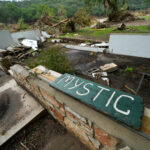River forecasters for the National Weather Service underestimated the flood level that a major river would reach during Nashville’s fatal May floods because they relied on inaccurate data from the U.S. Army Corps of Engineers, the service concluded in a report.
The report found that forecasters ignored two models that showed more accurate flood predictions for the Cumberland River in favor of a model that relied on inaccurate and untimely information from the corps. The weather service continued to use that data despite observations on the ground that proved their flood predictions were inaccurate.
That meant the weather service failed to warn of major flooding in Nashville until after it had already taken place. The flooding on May 1 and 2 killed 22 people around the state and caused more than $2 billion in damage in Nashville alone.
The report also found that many residents did not respond to its flood warnings because those warnings did not reflect the urgency of the situation.
“We can’t stop the rain, but we can and must do a better job at warning people of the potential for dangerous flooding,” U.S. Rep Jim Cooper, D-Nashville, said in a statement. “A few hours of warning could have saved lives and prevented millions of dollars in damage. ”
According to the report, by early Sunday, May 2, and possibly before, officials at the weather service’s Ohio River Forecast Center were concerned about a possible major flood of the Cumberland River _ defined as water levels of 45 feet and above at downtown Nashville.
Two other flooding simulations _ one was experimental and the other didn’t use corps’ data _ both predicted major flooding, with a crest possibly reaching 54 feet. But after a conference call with the corps at 8:30 a.m. that morning, the weather service issued a public prediction of flood levels reaching only 41.9 feet, just below the “moderate” flood level.
That prediction relied on the corps’ estimates of how much water it was releasing from dams. As a corps assessment of its actions during the flood previously found, the agency was constantly adjusting the flow from the dams but not updating the weather service about those changes.
The weather service report also makes clear that some of the flow data reported by the corps were not accurate even at the moment they were received.
On Sunday morning, the river exceeded the weather services’ predicted 41.9-foot crest in less than 2 hours. But the weather service was slow to update its prediction. It continued to rely on inaccurate and outdated information from the corps even though on-the-ground observations showed the river rising much more rapidly.
The river eventually crested at 51.86 feet in downtown Nashville at 6 p.m. on Monday. A more accurate prediction of a 51.5-foot crest did not come until 4 a.m. on Monday. A 52-foot crest was not forecast until 3:42 p.m., according to the report.
The report also criticizes the wording of the flood warnings. On April 30, the weather service’s Southern Regional headquarters sent an e-mail to local weather offices reminding them of the option to use “Flash Flood Emergency” in their warnings to the public. But the Nashville office never used the term “flood emergency,” despite “the many reports of catastrophic flooding, water rescues, and even fatalities” the report states.
And the report found that staffing levels were inadequate for the emergency.
“At critical times, the office was overwhelmed,” NWS Director Jack Haynes said in a conference call.
The assessment notes that progress has been made in interagency communication and cooperation. Haynes also said that high-resolution flood maps are being developed for the Nashville area that will show down to the street level where flooding is expected.
Was this article valuable?
Here are more articles you may enjoy.

 NYT Asks Judge to Dismiss Trump’s ‘Implausible’ Defamation Suit
NYT Asks Judge to Dismiss Trump’s ‘Implausible’ Defamation Suit  World’s Top 10 Extreme Weather Events in 2025
World’s Top 10 Extreme Weather Events in 2025  Flooding in California Leads to Soaked Roads, Water Rescues and 1 Death
Flooding in California Leads to Soaked Roads, Water Rescues and 1 Death  ‘Door Knocker’ Roofers Were Everywhere. NC Farm Bureau Saw an Opportunity
‘Door Knocker’ Roofers Were Everywhere. NC Farm Bureau Saw an Opportunity 